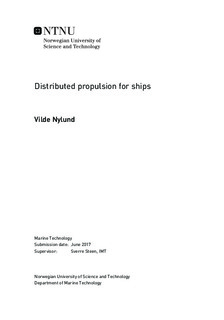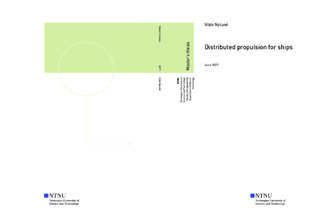| dc.description.abstract | It is anticipated that using distributed electric propulsion (DEP) on conventional ships will increase the total propulsive efficiency. This is mainly due to two reasons; firstly, because the total propeller disk area can be increased. Secondly, because each propeller can be optimised for the local wake where it is operating. In this work, the benefits of using DEP has been investigated for a 14 000 TEU container ship.
Based on a literary study of the present state of propeller modelling methods, it was decided to use lifting line theory to determine the thrust and torque of propellers in DEP configurations. The blade section geometry of the Wageningen B-screw series was used.
Emphasis was placed on programming a lifting line code in MatLab that could estimate propeller performance with sufficient accuracy. It was validated against polynomials describing the open water characteristics of the Wageningen B-screw series. It was found to provide sufficient accuracy for three- and four-bladed propellers, while relatively large discrepancies was present for two- and five-bladed propellers.
A built-in optimisation function in MatLab called fmincon was used to find the optimal geometry of each propeller. Its objective was to minimise the effect delivered to the propellers, without cavitation and with the propellers providing the required thrust for the ship to maintain its operational speed. The latter was achieved by application of a quadratic penalty method to force the total thrust within 3% of the required thrust.
The rate of revolution was optimised for each propeller, while all propellers were optimised to have the same blade area relationship in each configuration. The pitch was adjusted for each propeller by iteration such that the effective angle of attack was sufficiently small to prevent cavitation.
Configurations of propellers placed in a grid were analysed. The width of the grid was equal to BWL and the height was as the diameter of the original propeller. Problems regarding cavitation occurred for configurations with two rows of propellers. Thus emphasis was placed on configurations with one row.
Based on potential theory, it was expected that five propellers would be most efficient as they had the greatest total propeller disk area, and hence lightest total thrust loading. However, it was the configurations with seven propellers that were most efficient for three- and four-bladed propellers. Influence of nominal wake and relatively small difference in thrust loading between five and seven propellers are anticipated to be the reason why seven propellers resulted in the highest efficiency.
Overall it was concluded that application of DEP to conventional ships can increase the total propulsive efficiency. Results suggests that a DEP configuration of seven four-bladed propellers in one row can increase the propulsive efficiency by 10.75%. However, more extensive analysis are recommended and practical challenges remains to be investigated. | |

